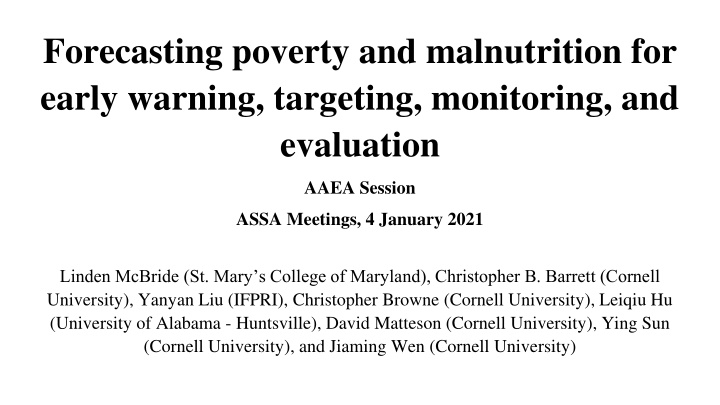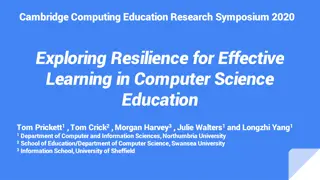
Innovative Approaches to Address Poverty and Malnutrition Challenges
Discover how leveraging big data and advanced methodologies can revolutionize the forecasting, targeting, monitoring, and evaluation of poverty and malnutrition for early intervention and effective humanitarian response. Explore the lessons learned from past emergencies and the importance of using appropriate tools for better outcomes in vulnerable communities. Consider the trade-offs, tools, and strategies for optimizing targeting and mapping efforts to address deprivation at household and geographic levels.
Download Presentation

Please find below an Image/Link to download the presentation.
The content on the website is provided AS IS for your information and personal use only. It may not be sold, licensed, or shared on other websites without obtaining consent from the author. If you encounter any issues during the download, it is possible that the publisher has removed the file from their server.
You are allowed to download the files provided on this website for personal or commercial use, subject to the condition that they are used lawfully. All files are the property of their respective owners.
The content on the website is provided AS IS for your information and personal use only. It may not be sold, licensed, or shared on other websites without obtaining consent from the author.
E N D
Presentation Transcript
Forecasting poverty and malnutrition for early warning, targeting, monitoring, and evaluation AAEA Session ASSA Meetings, 4 January 2021 Linden McBride (St. Mary s College of Maryland), Christopher B. Barrett (Cornell University), Yanyan Liu (IFPRI), Christopher Browne (Cornell University), Leiqiu Hu (University of Alabama - Huntsville), David Matteson (Cornell University), Ying Sun (Cornell University), and Jiaming Wen (Cornell University)
Lessons made salient by 2020 Emergencies can arise quickly effect their greatest devastation on communities that are already vulnerable and disadvantaged Significant information gaps impede effective/efficient humanitarian response Agencies need appropriate tools
Big data revolution? Data on human movement, behavior, interaction, and the natural and cultivated environments + simultaneous improvements in data science methods High quality, subnational maps (Blumenstock et al. 2015, Jean et al. 2016, Pokhriyal & Jacques 2017, Engstrom et al. 2017, Noor et al. 2008, Head et al. 2017, Hersh et al. 2020, Masaki et al. 2020, Yeh et al. 2020, Browne et al. 2021) Household level poverty and malnutrition targeting (Kshirsagar et al. 2017, McBride & Nichols 2018, Knippenberg et al. 2019) Early warning (Mude et al. 2009, Lentz et al. 2018, Tang et al. 2018, Yeh et al. 2020, Browne et al. 2021 ) Can big data revolutionize poverty and malnutrition mapping, targeting, M&E and forecasting?
Caution : Agencies needs vary Trade offs Asset-based models versus most predictive feature set Highly predictive model with hundreds of features from disparate sources (Pokhriyal & Jacques 2017) versus a lean data tool (Schriener 2007, Kshirsagar et al. 2017, Baez et al. 2019) Purpose and use case What type of deprivation is being mapped/targeted/monitored/forecasted? What is the time horizon? How transparent/accessible does the final model need to be? How onerous is the data collection and curation task?
Fit tools to tasks Targeting versus mapping Current versus chronic Static versus dynamic Data
Targeting versus mapping Targeting tools (Grosh & Baker 1995, Coady, Grosh & Hoddinott 2004, Schriener 2007) Parameterize a tool for targeting, M&E of households Stocks on RHS, flows on LHS Mapping (Ghosh & Rao 1994, Rao 1999, Elbers et al. 2003, Coudouel & Bedi 2007) Estimate spatial distribution of deprivation for targeting, M&E of geographic areas Targeting identifies poor/malnourished people while mapping estimation identifies poor/malnourished places
Targeting versus mapping: Targeting innovations Scorecard approach to proxy means test development using machine learning for dimension reduction and out of sample validation for model assessment Important innovations Lean data (Schriener 2007, Kshirsagar et al. 2017, Baez et al. 2019) High frequency data (Knippenberg et al. 2019) Administrative data (Alt nda et al. 2021)
Targeting versus mapping: Mapping innovations Combining different data inputs using CNN or other ML methods to estimate measures of deprivation at local levels Important innovations Cell Data Records (Blumenstock et al. 2015) Nightlights, daytime satellite imagery, NDVI, remotely sensed data (Jean et al. 2016, Yeh et al. 2020) Combined data sources (Pokhriyal & Jacques 2017, Yeh et al. 2020) Multidimensional Poverty Index (Pokhriyal & Jacques 2017, Njuguna & McSharry 2017) Open source data (Hersh et al. 2020) Multivariate prediction of correlated outcomes (Browne et al. 2021)
Targeting versus mapping: Frontiers Multi-dimensional nature of deprivation Predicting low probability/noisy outcomes (Head et al. 2017) Limitations of available data (Blumenstock 2016 & 2020) Determinants of geographically concentrated poverty (Yeh et al. 2020)
Chronic versus current The poor and malnourished include those who are chronically as well transitorily in a state of deprivation Evidence that the transitory poor/food insecure make up the majority poor/food insecure (Baulch & Hoddinott 2000, Knippenberg et al. 2020) Heterogeneity in spell length
Chronic versus current Asset based theory (and empirics) of poverty traps asset holdings are important inputs/outputs in targeting/mapping/forecasting long term deprivation Big data (most predictive feature set) approach model with highest out of sample R2may not identify chronic poor/food insecure Innovations Recent mapping models do relatively well predicting asset poverty across space (Blumenstock et al. 2015, Jean et al. 2016, Yeh et al. 2020, Browne et al. 2021) and over time (Yeh et al. 2020, Browne et al. 2021)
Chronic versus current: Frontiers Parsing persistently poor from the dynamically mobile: fourth generation well-being assessment (Carter & Barrett 2006) better mapping well-being dynamics Resilience targeting/ resilience mapping (Barrett and Constas 2014, Cisse & Barrett 2018, Upton, Cisse & Barrett 2016, Knippenberg et al. 2019)
Static versus dynamic Mapping and targeting efforts tend to produce static models Static models are important for monitoring and evaluation (can fill in gaps in the data) Early warning systems identify those who will be poor/malnourished/food insecure in the next period anticipate the impact of shocks on vulnerable populations are concerned with changes (not just levels) model welfare dynamics with panel data
Static versus dynamic: Innovations Food insecurity early warning using high frequency data (Mude et al. 2009, Lentz et al. 2018) Tang et al. (2018), Yeh et al. (2020) demonstrate that CNNs trained on changes in satellite imagery can predict changes in consumption or asset wealth in future periods Browne et al. (2021) produce contemporaneous and sequential prediction of correlated asset wealth and malnutrition indicators
Static versus dynamic: Frontiers High frequency data needed for monitoring and early warning (Barrett 2010, Headey & Barrett 2015) Slowest changing features have highest predictive power over time (c.f. chronic versus current) Integration of time series statistics with ML tools with application in these settings
Data ML informed map, tool, or model will only be as good as the data on which it is trained and tested undersupply of the global public good of collection, standardization, updating and open access curation of key variables one can only predict with accuracy states and processes that have been previously observed in data assumed stationarity in DGP COVID has likely accelerated trends towards more creative data collection (Blumenstock 2020)
Data: Frontiers Tradeoffs Data needs of predictive model versus ease of data curation and updating Returns from combining data sources Spatial resolution vs. temporal resolution vs. length of time series Needs/challenges Sentinel sites (variation where it is needed) (Barrett 2010, Headey & Barrett 2015) Balancing information on vulnerable against privacy and protection
Conclusion Big data and ML methods are revolutionizing mapping, targeting, M&E, and early warning However, effective use requires thoughtful consideration of the purpose and use cases of the map/tool/model Data availability and curation remain a serious limitation No targeting, mapping, or early warning model will be effective without the political will and financial support to take action/intervene.
Thank you! Questions/Comments Email: lemcbride@smcm.edu Twitter: @LindenMcBride Acknowledgements: Financial support for this research was provided by USAID under cooperative agreement # 7200AA18CA00014, Innovations in Feed the Future Monitoring and Evaluation - Harnessing Big Data and Machine Learning to Feed the Future. The contents are solely the authors responsibility and do not necessarily reflect the views of USAID or the United States Government.








